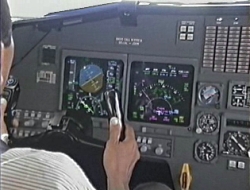
 L12 Luzes de Cabeceira (verde no início e vermelha no fim da pista)
L12 Luzes de Cabeceira (verde no início e vermelha no fim da pista)L14 Luzes ao longo das laterais da pista, de 60 em 60 metros
L15 Luzis azuis de pista de táxi, indicando sua trajetória
L21 Farol rotativo de aeródromo
L26 Indicador iluminado de direção do vento


 Effects of Weight
Effects of WeightMost modern aircraft are so designed that if all seatsare occupied, all baggage allowed by the baggage compartment is carried, and all of the fuel tanks arefull, the aircraft will be grossly overloaded. This type ofdesign requires the pilot to give great consideration to the requirements of the trip.
If maximum range is required, occupants or baggage must be left behind, or if the maximum load must be carried, the range, dictated by theamount of fuel on board, must be reduced.
Some of the problems caused by overloading an aircraftare:
• the aircraft will need a higher takeoff speed, whichresults in a longer takeoff run.
• both the rate and angle of climb will be reduced.
• the service ceiling will be lowered.
• the cruising speed will be reduced.
• the cruising range will be shortened.
• maneuverability will be decreased.
• a longer landing roll will be required because thelanding speed will be higher.
• excessive loads will be imposed on the structure,especially the landing gear.
The POH or AFM includes tables or charts that give thepilot an indication of the performance expected for anyweight. An important part of careful preflight planning includes a check of these charts to determine the aircraft isloaded so the proposed flight can be safely made.
Weight Changes
The maximum allowable weight for an aircraft is determined by design considerations. However, the maximum operational weight may be less than the maximum allowable weight due to such considerations as high-density altitude or high-drag field conditions caused by wet grass or water on the runway. The maximum operational weight may also be limited by the departure orarrival airport’s runway length.
One important preflight consideration is the distribution of the load in the aircraft.
Loading the aircraft so the gross weight is less than the maximum allowable is not enough.
This weight must be distributed to keep the CG within the limits specified in the POH or AFM.
If the CG is too far forward, a heavy passenger can be moved to one of the rear seats or baggage can be shifted from a forward baggage compartment to a rear compartment. If the CG is too far aft, passenger weight or baggage can be shifted forward. The fuel load should be balanced laterally: the pilot should pay special attention to the POH or AFM regarding the operation of the fuel system, in order to keep the aircraft balanced in flight.
Weight and balance of a helicopter is far more critical than for an airplane. With some helicopters, they may be properly loaded for takeoff, but near the end of a long flight when the fuel tanks are almost empty, the CG may have shifted enough for the helicopter to be out of balance laterally or longitudinally. Before making any long flight, the CG with the fuel available for landing must be checked to ensure it will be within the allowable range.
Airplanes with tandem seating normally have a limitation requiring solo flight to be made from the front seat in some airplanes or the rear seat in others. Some of the smaller helicopters also require solo flight be made from a specific seat, either the right, left, or center. These seating limitations will be noted by a placard, usually on the instrument panel, and they should be strictly adhered to.
As an aircraft ages, its weight usually increases due to trash and dirt collecting in hard-to-reach locations, and moisture absorbed in the cabin insulation. This growth in weight is normally small, but it can only be determined by accurately weighing the aircraft.
Shifting the CG
One common weight and balance problem involves moving passengers from one seat to another or shifting baggage or cargo from one compartment to another tomove the CG to a desired location. This also can be visualized by using a board with three weights and then working out the problem the way it is actually done on an airplane.
Multiengine Airplane
Weight and Balance
Computations
Weight and balance computations for small multiengine airplanes are similar to those discussed for single-engine airplanes. See Figure 4-9 for an example of weight and balance data for a typical light twin-engine airplane.
How To Prevent Landing Errors Due to Optical Illusions
To prevent these illusions and their potentially hazardous consequences, pilots can:
1. Anticipate the possibility of visual illusions during approaches to unfamiliar airports, particularly at night or in adverse weather conditions. Consult airport diagrams and the Airport/Facility Directory (A/FD) for information on runway slope, terrain, and lighting.
2. Make frequent reference to the altimeter, especially during all approaches, day and night.
3. If possible, conduct aerial visual inspection of unfamiliar airports before landing.
4. Use Visual Approach Slope Indicator (VASI) or Precision Approach Path Indicator (PAPI) systems for a visual reference, or an electronic glide slope, whenever they are available.
5. Utilize the visual descent point (VDP) found on many nonprecision instrument approach procedure charts.
6. Recognize that the chances of being involved in an approach accident increase when some emergency or other activity distracts from usual procedures.
7. Maintain optimum proficiency in landing procedures.






Nenhum comentário:
Postar um comentário